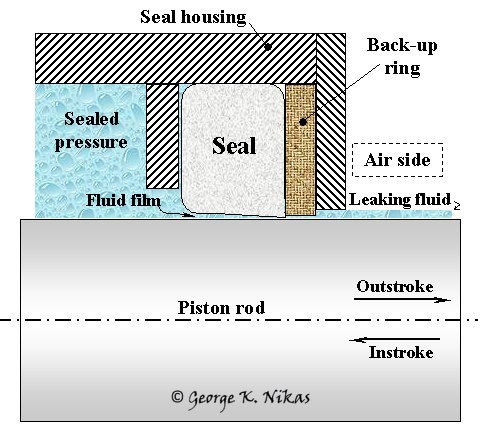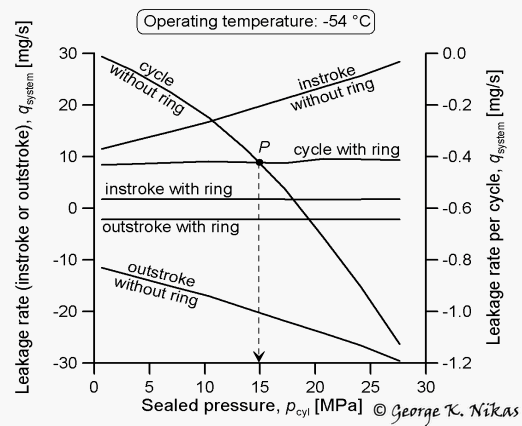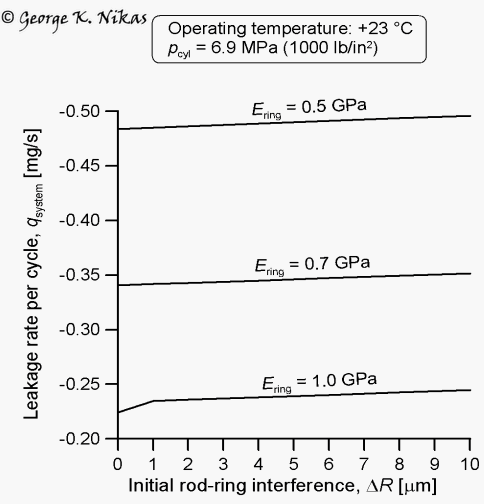
Paper: Theoretical study of solid back-up rings for elastomeric seals in hydraulic actuators.
Author: George K. Nikas
Published in: Tribology
International, 2004, 37(9), 689-699
Abstract
The use of back-up rings to support elastomeric seals in high-pressure hydraulic systems is well established in the industry. However, little is known about the operation of such devices and how they affect or interfere in the sealing mechanism of the seals they accompany. This study is an attempt to model solid, soft back-up rings in terms of elastohydrodynamic lubrication and establish their exact role in a sealing system in terms of sealing performance (leakage). The model is applied on a typical case of a linear hydraulic actuator for a wide range of sealed pressures (1 to 35 MPa) and operating temperatures (55 to +135 °C), and with one ring installed on the low-pressure side of the actuator. A system of a rubber seal and a properly selected and installed back-up ring is shown to be often significantly more efficient in terms of fluid leakage than the seal without the back-up ring. A study reveals the effect of various parameters of the ring (for example, the elastic modulus and the surface roughness) on the sealing mechanism and shows the optimum selection to minimize leakage.
Some figures from this work
The hydraulic actuator and seal configuration for the model is shown in Fig. 1. The actuator contains fluid under pressure, usually between 0.1 and 35 MPa, and operates between 60 and +140 ēC. The piston rod reciprocates and fluid leaks under the elastomeric seal, past the (optional) back-up ring, and escapes to the air side of the system.

Fig. 1. Configuration for the seal model.
Figure 2 below shows the seal and the system (seal + back-up ring) leakage at 54 °C during an instroke, an outstroke and a cycle (instroke + outstroke), for sealed pressures between 0.7 MPa (100 lb/in2) and 27.6 MPa (4000 lb/in2). The back-up ring (elastic modulus of 1 GPa) has initial radial interference of 10 microns with the piston rod. This creates contact pressure, in addition to the sealed pressure that is transferred to the ring via the adjacent seal. Figure 2 shows that the back-up ring improves the leakage performance of the system above a sealed pressure (of 15 MPa in the example). For sealed pressures below the critical pressure of 15 MPa (corresponding to point P in the figure), the back-up ring worsens the leakage of the system. The location of point P depends on the operating temperature as is shown in other figures in the paper.

Fig. 2. Effect of the sealed pressure on leakage at 54 °C.
Figure 3 below shows the effect on the leakage-per-cycle of the initial radial interference between the piston rod and the back-up ring, with the elastic modulus of the ring as a parameter. The results shown refer to room temperature and sealed pressure of 6.9 MPa (1000 lb/in2). It is shown that the interference has a small effect on leakage but the elastic modulus of the ring has a more significant effect.

Fig. 3. Effect of the rod-ring interference on leakage for variable ring elastic modulus.
Figure 4 below shows the effect of the average surface roughness of the back-up ring on the system leakage-per-cycle, with the sealed pressure as a parameter. The results refer to room temperature. It is seen that the ring roughness has an insignificant effect on system leakage. The effect of the sealed pressure on the other hand is greater but also small in absolute terms.

Fig. 4. Effect of the ring average surface roughness on leakage.
For more information in this research area, please see the author's related sealing project.